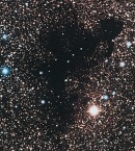A) convection
B) radiation
C) conduction
D) All of the other choices are correct.
Correct Answer

verified
Correct Answer
verified
Multiple Choice
Protostars are difficult to observe because
A) the protostar stage is very short.
B) they are surrounded by cocoons of gas and dust.
C) they radiate mainly in the infrared.
D) the protostar stage is very short, they are surrounded by cocoons of gas and dust, and they radiate mainly in the infrared.
E) they are all so far away that the light hasn't reached us yet.
Correct Answer

verified
Correct Answer
verified
Multiple Choice
 -The above image is an example of a/an _________ nebula.
-The above image is an example of a/an _________ nebula.
A) dark
B) emission
C) Bok globule
D) reflection
Correct Answer

verified
Correct Answer
verified
True/False
The dust in the interstellar medium can make distant stars look redder than they really are.
Correct Answer

verified
Correct Answer
verified
True/False
Pre-main-sequence stars are above and to the right of the main sequence.
Correct Answer

verified
Correct Answer
verified
Essay
Why are reflection nebulae blue in color
Correct Answer

verified
Reflection nebulae look blue for the sam...View Answer
Show Answer
Correct Answer
verified
View Answer
Multiple Choice
 -The above visual wavelength image of the Trapezium cluster shows _________.
-The above visual wavelength image of the Trapezium cluster shows _________.
A) main sequence and protostars
B) protostars and YSOs
C) YSOs and ZAMS
D) ZAMS and protostars
Correct Answer

verified
Correct Answer
verified
Multiple Choice
The central cores of which type of star is the lowest temperature
A) protostars.
B) massive main-sequence stars.
C) white dwarf stars.
Correct Answer

verified
Correct Answer
verified
Multiple Choice
________ occurs when most of the material collapsing to form a protostar has fallen into a disk around the star and a strong wind from the warm protostar ejects material from its poles.
A) An emission nebula
B) Hydrostatic equilibrium
C) The proton-proton chain
D) The thermonuclear fusion of hydrogen
E) A bipolar outflow
Correct Answer

verified
Correct Answer
verified
Multiple Choice
Which of the following in not a factor that prevents molecular cloud contraction
A) thermal motion
B) a force exerted by a magnetic field
C) orbital motion
D) turbulence
Correct Answer

verified
Correct Answer
verified
Essay
Why is there a lower end to the main sequence
Correct Answer

verified
The mass-luminosity relation tells you w...View Answer
Show Answer
Correct Answer
verified
View Answer
Multiple Choice
The densest, coldest clouds are called _____________.
A) reflection nebula
B) dark nebula
C) Bok globules
D) molecular clouds
Correct Answer

verified
Correct Answer
verified
Short Answer
____________________ appear reddish in color due to the light emitted by the Balmer series of the hydrogen atom.
Correct Answer

verified
Emission n...View Answer
Show Answer
Correct Answer
verified
View Answer
True/False
The above image is an example of interstellar reddening. 
Correct Answer

verified
Correct Answer
verified
Multiple Choice
________ is the thermonuclear fusion of hydrogen to form helium operating in the cores of massive stars on the main sequence.
A) The CNO cycle
B) The proton-proton chain
C) Hydrostatic equilibrium
D) The neutrino process
E) None of the above
Correct Answer

verified
Correct Answer
verified
Multiple Choice
While on the main sequence a star's primary energy source comes from
A) nuclear fusion.
B) nuclear fission.
C) gravitational potential energy.
D) magnetic fields.
Correct Answer

verified
Correct Answer
verified
Showing 121 - 136 of 136
Related Exams